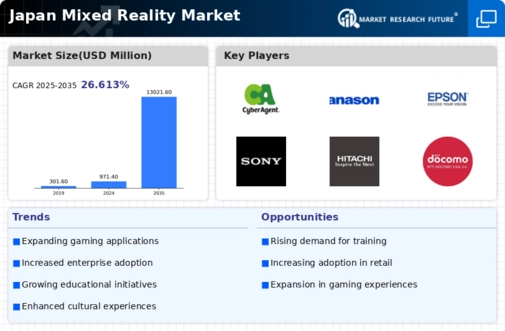Government Support and Initiatives
The mixed reality market in Japan is benefiting from supportive government policies and initiatives aimed at fostering technological innovation. The Japanese government has recognized the potential of mixed reality to drive economic growth and is investing in research and development programs. Initiatives such as funding for startups and partnerships with educational institutions are designed to promote the adoption of mixed reality technologies across various sectors. This support is likely to accelerate market growth, as it encourages collaboration between private and public entities. Additionally, government-led projects focusing on smart cities and digital transformation are expected to incorporate mixed reality solutions, further expanding the market landscape. As these initiatives gain momentum, the mixed reality market is likely to flourish, supported by a conducive regulatory environment.
Integration in Industrial Applications
The mixed reality market is increasingly being integrated into industrial applications in Japan, particularly in manufacturing and maintenance sectors. Companies are recognizing the potential of mixed reality to improve operational efficiency and reduce costs. For example, mixed reality solutions are being utilized for remote assistance, allowing technicians to receive real-time guidance while performing complex tasks. This integration is expected to enhance productivity by up to 25%, as workers can access critical information without interrupting their workflow. Furthermore, Japanese manufacturers are investing in training programs that utilize mixed reality to upskill employees, indicating a commitment to leveraging this technology for workforce development. As industries continue to adopt mixed reality solutions, the market is poised for substantial growth, driven by the need for innovative tools that enhance productivity and safety.
Technological Advancements in Hardware
The mixed reality market in Japan is experiencing a surge due to rapid advancements in hardware technology. Innovations in headsets, sensors, and display technologies are enhancing user experiences, making mixed reality applications more accessible and appealing. For instance, the introduction of lightweight, high-resolution headsets has improved comfort and usability, leading to increased adoption across various sectors. The market is projected to grow at a CAGR of approximately 30% from 2025 to 2030, driven by these technological improvements. Furthermore, Japanese companies are investing heavily in research and development to create cutting-edge devices that cater to both consumer and enterprise needs. This focus on hardware innovation is likely to propel the mixed reality market forward, as enhanced devices enable more immersive and interactive experiences.
Increased Focus on Healthcare Solutions
The mixed reality market is increasingly focusing on healthcare solutions in Japan, where the demand for innovative medical technologies is on the rise. Mixed reality applications are being developed for surgical training, patient education, and rehabilitation, enhancing the overall quality of care. For instance, mixed reality simulations are being utilized to train medical professionals, allowing them to practice complex procedures in a risk-free environment. The healthcare sector is projected to account for a significant share of the mixed reality market, with investments expected to reach approximately $1 billion by 2027. This growth is driven by the need for effective training tools and patient engagement strategies. As healthcare providers continue to explore the benefits of mixed reality, the market is likely to expand, reflecting a growing recognition of its potential to transform medical practices.
Rising Demand in Entertainment and Gaming
The mixed reality market is witnessing a notable increase in demand within the entertainment and gaming sectors in Japan. As consumers seek more immersive experiences, developers are leveraging mixed reality technologies to create engaging content that captivates audiences. The gaming industry, in particular, is projected to contribute significantly to market growth, with revenues expected to reach approximately $3 billion by 2026. This trend is fueled by the popularity of mixed reality games that blend real-world environments with digital elements, providing players with unique experiences. Additionally, entertainment venues are adopting mixed reality solutions to enhance visitor engagement, suggesting a broader acceptance of this technology. As the appetite for innovative entertainment options grows, the mixed reality market is likely to expand, driven by consumer enthusiasm and industry investment.



















Leave a Comment